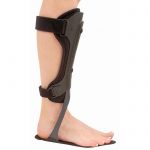The idea of using an exoskeleton to enhance a human body has been around for a while but for many reasons they are impractical so how about exosuits?
Small and soft exosuits may be the way forwards for those who are unable to or struggle to walk. The major fault of skeletons and suits has always been related to efficiency. There is no benefit to using a skeleton or suit if, due to factors such as weight, the metabolic penalty outweighs the efficiency gained i.e it costs more energy to use it than energy saved by using it. There is also no benefit to using a system like this if it feel unnatural to move around or creates an altered gait pattern.
The feeling is most noticable when you turn it off after using it. Think of the sensation as sluggish and heavy legs.
A study in Science/Robotics has performed an experiment using a new type of multi-joint soft exosuit investigating if this new model saves energy during normal walking. Assistance was applied to the ankle and hip joints by the motor and tether mechanism. Seven participants walked on a treadmill at 1.5 meters per second under one unpowered and four powered conditions, where the peak moment applied at the ankle joint was varied from about 10 to 38% of biological ankle moment (equivalent to an applied force of 18.7 to 75.0% of body weight).

Overall this type of exosuit showed to make walking more efficient in terms of energy expended during walking as well as a reduced load for the hip and ankle muscles. The comfort and ease of the suit were easy and the only noticeable difference to the user was when stopped abruptly. “The feeling is most noticeable when you turn it off after using it. Think of the sensation as sluggish and heavy legs”.
This is encouraging news as currently people with movement or neurological disorders have to rely on clunky or passive/dynamic orthoses (similar to the image above) which can be exhausting to use or require the user to alter the way they walk to maximise their effects. This suit however saved 23% of energy.